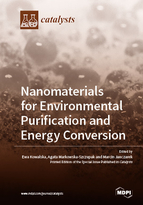Nanomaterials for Environmental Purification and Energy Conversion
A special issue of Catalysts (ISSN 2073-4344). This special issue belongs to the section "Environmental Catalysis".
Deadline for manuscript submissions: closed (15 May 2018) | Viewed by 98848
Special Issue Editors
Interests: heterogeneous photocatalysis; advanced oxidation processes (AOPs); environmental purification; plasmonic nanoparticles; antimicrobial properties; visible-light-responsive materials
Special Issues, Collections and Topics in MDPI journals
Interests: photocatalysis, nanomaterials, faceted nanoparticles, solar energy, advanced oxidation technologies
Special Issues, Collections and Topics in MDPI journals
Interests: biotechnology; microbiology; drug delivery; nanomedicine; nanotechnology; cell biology; bionanoscience; nanomaterials
Special Issues, Collections and Topics in MDPI journals
Special Issue Information
Dear Colleagues,
The Symposium on Nanomaterials for Environmental Purification and Energy Conversion (SNEPEC) will be held in "snowy" city of Sapporo, at Hokkaido University, from 20 to 21 February, 2018.
The Symposium is organized (and sponsored) by the Institute for Catalysis, Hokkaido University, to share the knowledge and the development of catalysis science.
SPEPEC will have an exciting scientific program lead by renowned international experts, which will focus on the central role of catalysis in solving environmental and energy problems of modern societies at the interface of material, chemistry and environmental sciences.
The list of confirmed speakers includes, Michael R. Hoffmann (Caltech, USA; http://hoffmann.caltech.edu/), Detlef Bahnemann (Leibniz University of Hannover, Germany; https://www.lnqe.uni-hannover.de/bahnemann.html?&L=1), Bunsho Ohtani (Hokkaido University, http://pcat.cat.hokudai.ac.jp/pcat/), Teruhisa Ohno (Kyushu Institute of Technology, Japan; https://research02.jimu.kyutech.ac.jp/html/98_en.html), Ryu Abe (Kyoto University, Japan; http://www.ehcc.kyoto-u.ac.jp/eh41/home/abe/en/profile/), Michael Wark (University Oldenburg, Germany; https://www.uni-oldenburg.de/tc-wark/).
The SNEPEC welcomes participants from industry, government, as well as academia, which are cordially invited to contribute original research papers or reviews to this Special Issue of Catalysts. The contributions from those who would like, but could not attend to the SNEPEC, are also welcome.
For more details, please visit http://www.cat.hokudai.ac.jp/icat-nepec/.
Prof. Ewa Kowalska
Dr. Marcin Janczarek
Prof. Agata Markowska-Szczupak
Guest Editors
Manuscript Submission Information
Manuscripts should be submitted online at www.mdpi.com by registering and logging in to this website. Once you are registered, click here to go to the submission form. Manuscripts can be submitted until the deadline. All submissions that pass pre-check are peer-reviewed. Accepted papers will be published continuously in the journal (as soon as accepted) and will be listed together on the special issue website. Research articles, review articles as well as short communications are invited. For planned papers, a title and short abstract (about 100 words) can be sent to the Editorial Office for announcement on this website.
Submitted manuscripts should not have been published previously, nor be under consideration for publication elsewhere (except conference proceedings papers). All manuscripts are thoroughly refereed through a single-blind peer-review process. A guide for authors and other relevant information for submission of manuscripts is available on the Instructions for Authors page. Catalysts is an international peer-reviewed open access monthly journal published by MDPI.
Please visit the Instructions for Authors page before submitting a manuscript. The Article Processing Charge (APC) for publication in this open access journal is 2700 CHF (Swiss Francs). Submitted papers should be well formatted and use good English. Authors may use MDPI's English editing service prior to publication or during author revisions.
Keywords
-
Heterogeneous photocatalysis
-
Nanomaterials fabrication
-
Environmental purification
-
Energy conversion
-
Water splitting
-
New techniques of nanomaterials characterization
-
Morphology-governed activity
-
Removal of microbiological pollutants
-
Water/wastewater treatment
-
Air treatment
-
Self-cleaning surfaces
-
Mechanism of pollutants’ decomposition








